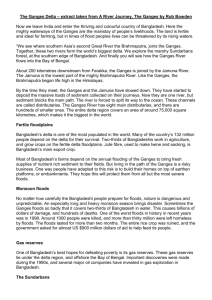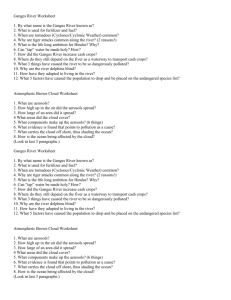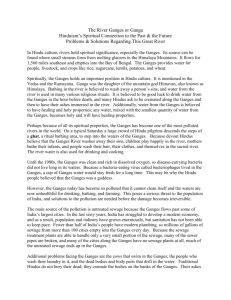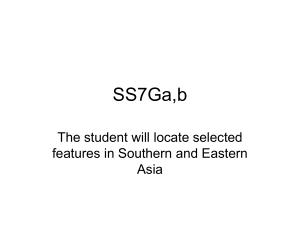5 4 The Ganges
advertisement
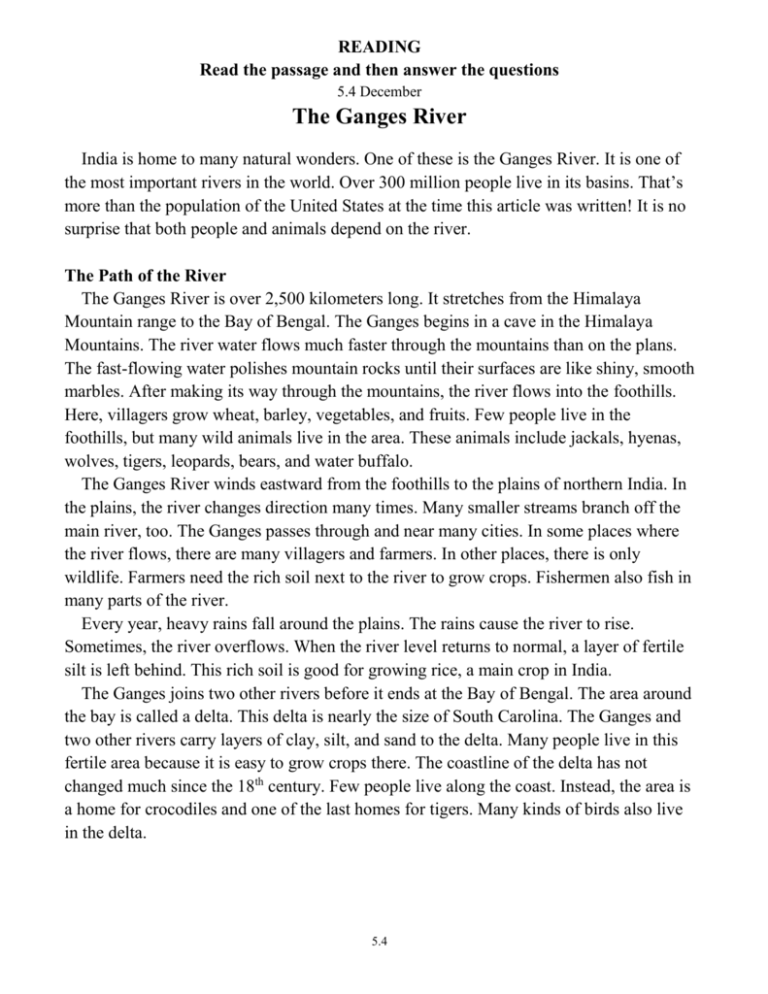
READING Read the passage and then answer the questions 5.4 December The Ganges River India is home to many natural wonders. One of these is the Ganges River. It is one of the most important rivers in the world. Over 300 million people live in its basins. That’s more than the population of the United States at the time this article was written! It is no surprise that both people and animals depend on the river. The Path of the River The Ganges River is over 2,500 kilometers long. It stretches from the Himalaya Mountain range to the Bay of Bengal. The Ganges begins in a cave in the Himalaya Mountains. The river water flows much faster through the mountains than on the plans. The fast-flowing water polishes mountain rocks until their surfaces are like shiny, smooth marbles. After making its way through the mountains, the river flows into the foothills. Here, villagers grow wheat, barley, vegetables, and fruits. Few people live in the foothills, but many wild animals live in the area. These animals include jackals, hyenas, wolves, tigers, leopards, bears, and water buffalo. The Ganges River winds eastward from the foothills to the plains of northern India. In the plains, the river changes direction many times. Many smaller streams branch off the main river, too. The Ganges passes through and near many cities. In some places where the river flows, there are many villagers and farmers. In other places, there is only wildlife. Farmers need the rich soil next to the river to grow crops. Fishermen also fish in many parts of the river. Every year, heavy rains fall around the plains. The rains cause the river to rise. Sometimes, the river overflows. When the river level returns to normal, a layer of fertile silt is left behind. This rich soil is good for growing rice, a main crop in India. The Ganges joins two other rivers before it ends at the Bay of Bengal. The area around the bay is called a delta. This delta is nearly the size of South Carolina. The Ganges and two other rivers carry layers of clay, silt, and sand to the delta. Many people live in this fertile area because it is easy to grow crops there. The coastline of the delta has not changed much since the 18th century. Few people live along the coast. Instead, the area is a home for crocodiles and one of the last homes for tigers. Many kinds of birds also live in the delta. 5.4 Religious Importance At first glance, the river is a muddy, dull body of water. For many Indians, however, the Ganges River is a religious symbol. People travel from all over the country to see the river. Some of them believe that the river dropped down from heaven to the earth below. Other Indians believe the river is a goddess. Ganga Devi, in the form of water. Many visitors also believe that the water can wash away sins. That is why so many people take baths in the water. And visitors also visit the temples that stand along the river’s banks. Others drink the water or even take a sample of the “holy water” with them when they return home. In the past, some Indian rulers drank nothing but water from the Ganges. Many people depend on the Ganges River. Farmers and villagers need the river to grow food and to raise animals. The river is also an important symbol to millions of people in India. For these reason, the Ganges River is one of the most important rivers in the world. People bathing in the Ganges 5.4 Student’s Name: ___________________________________________________________ Teacher: ____________________________Date:_________________________________ Multiple choice questions: The Ganges River CIRCLE YOUR ANSWER 1. Which of the following is an opinion expressed by the author of the passage? a. The Ganges River is a religious symbol for many Indians. b. The coastline of the delta is one of the last homes for tigers. c. Over 300 million people live in the basins of the Ganges River. d. The Ganges River is one of the most important rivers in the world. 2. Which of the following is a fact supported by the passage? a. Tigers like the river the most of all the animals that live near it. b. The muddy, ugly river is interesting to follow through the mountains. c. The river flows from the Himalaya Mountains to the Bay of Bengal. d. The prettiest stones can be found near the river. 3. Which of the following is a fact from the story? a. People like the fast flowing waters b. The fast flowing waters polish rocks until they are like shiny, smooth marbles c. People enjoy growing wheat the most in the plains d. The Ganges river winds Westward from the foothills 4. Which of the following contains an opinion? a. When the river flow returns to normal, silt is left behind. b. Farmers like the silt along the river for growing their crops and they believe they have the best view in the world. c. Many people live in the delta area because the land is fertile. d. Few people live along the coast. 5. Which of the following statements is an opinion? a. The river changes direction many times. b. Both people and animals depend on the river. c. The water washes away the sins of visitors. d. Villagers grow wheat, barley, vegetables, and fruits by the river. OPEN ENDED SCORE:________ Turn over for open ended 5.4 READING OPEN-ENDED ITEM FOR The Ganges River Why is the Ganges River important to the people who live near it? Use three details from the passage to support your response. 5.4 MC Answer Key for The Ganges 5.4 1. d 2. c 3. b 4. c 5. c 5.4

